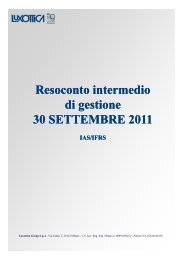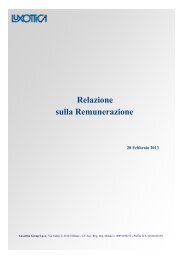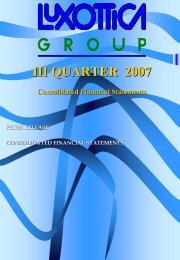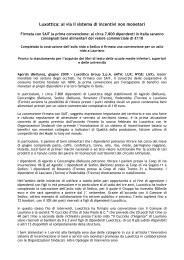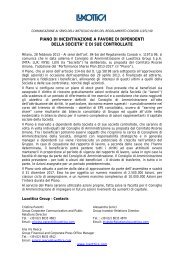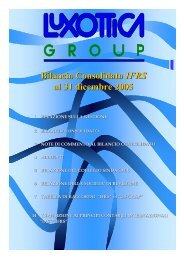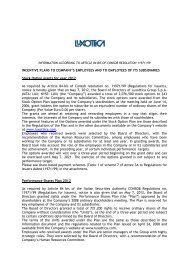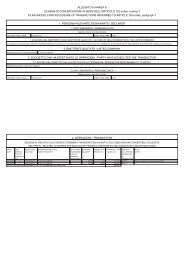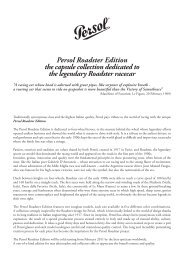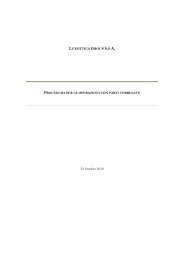Annual Review 2012 - Luxottica
Annual Review 2012 - Luxottica
Annual Review 2012 - Luxottica
You also want an ePaper? Increase the reach of your titles
YUMPU automatically turns print PDFs into web optimized ePapers that Google loves.
Consolidated financial statements - NOTES<br />
| 119 ><br />
and those that are not reclassified to profit or loss (non-recyclable). If items of other<br />
comprehensive income are presented before tax, then income tax is allocated to each<br />
respective group. The amendments do not change the existing option to present an<br />
entity’s performance in two statements; and do not address the content of performance<br />
statements (i.e., what is recognized in profit or loss and what is recognized in other<br />
comprehensive income) or recycling issues (i.e., what can be reclassified (recycled)<br />
subsequently to profit or loss and what cannot). The amendments are effective for fiscal<br />
years commencing after July 1, <strong>2012</strong>. The Group has not early adopted the amendments<br />
to IAS 1. The European Commission endorsed the standard on June 5, 2010 with<br />
regulation number 475.<br />
Amendments to IAS 19 - Employee benefits, issued in June 2011. The standards make<br />
significant changes to the recognition and measurement of defined benefit pension<br />
expense and termination benefits, and to the disclosures for all employee benefits.<br />
Actuarial gains and losses are renamed “re-measurements” and will be recognized<br />
immediately in “Other Comprehensive Income” (OCI) and will never be recycled to<br />
profit and loss in subsequent periods. Past-service costs will be recognized in the<br />
period of a plan amendment; unvested benefits will no longer be spread over a future<br />
service period. A curtailment now occurs only when an entity reduces significantly<br />
the number of employees. Curtailment gains/losses are accounted for as past-service<br />
costs. <strong>Annual</strong> expense for a funded benefit plan will include net interest expense or<br />
income, calculated by applying the discount rate to the net defined benefit asset or<br />
liability. There will be less flexibility in income statement presentation. Benefit cost<br />
will be split between (i) the cost of benefits accrued in the current period (service<br />
cost) and benefit changes (past-service cost, settlements and curtailments) and (ii)<br />
finance expense or income. This analysis can appear in the income statement or in the<br />
notes. The standard is effective for annual periods beginning on or after January 1,<br />
2013. Earlier application is permitted. The Group has not early adopted the standard.<br />
The European Commission endorsed the standard on June 5, 2010 with regulation<br />
number 475. The Group estimated that the application of the standard will result in an<br />
increase in pension expense in 2013 of approximately Euro 17.5 million (approximately<br />
Euro 11.9 million in <strong>2012</strong>).<br />
IAS 28 - Investments in Associates and Joint ventures, issued in May 2011. The standard<br />
supersedes IAS 28 Investments in associates, as amended in 2003. The standard<br />
incorporates the accounting for joint ventures and certain amendments discussed by the<br />
standard setting board during its deliberations on the exposure draft ED 9. For IAS 28 the<br />
IASB indicated January 2013 as the effective date. The European Commission endorsed<br />
the standard on December, 11 <strong>2012</strong> with regulation number 1254 and postponed by<br />
one year the original effective date set by the IASB. The standard is now effective for<br />
annual periods beginning on or after January 1, 2014 at the latest. The Group believes<br />
that the application of IAS 28 will not have significant impact on its consolidated financial<br />
statements.<br />
Amendment to IFRS 7 and IAS 32 - Offsetting financial assets and financial liabilities. The<br />
amendments require additional quantitative information which enables the users to better<br />
compare and reconcile the information provided by the financial statements as a result<br />
of the application of IFRS 7and IAS 32. The amendment is effective for annual periods



